51 pages • 1 hour read
Laurie GarrettThe Coming Plague: Newly Emerging Diseases in a World Out of Balance
Nonfiction | Book | Adult | Published in 1994A modern alternative to SparkNotes and CliffsNotes, SuperSummary offers high-quality Study Guides with detailed chapter summaries and analysis of major themes, characters, and more.
Introduction-Chapter 3Chapter Summaries & Analyses
Introduction Summary
Garrett begins the book with a sketch of her Uncle Bernard’s medical service during World War II, contrasting his experience with tropical diseases and the vanishing familiarity with such illnesses in modern medicine. With the rise of antibiotics and vaccinations in the mid-20th century, often achieving significant milestones in the eradication of disease, many medical professionals fell into a casual optimism that devastating epidemics would soon be a relic of the past. However, by the late 1970s and early 1980s, those blithe assumptions were being shaken. Outbreaks of new hemorrhagic diseases in Africa terrified news audiences around the globe, and the widespread transmission of AIDS in the United States began to wake medical experts up to their own complacency. Even so, the global response to the AIDS epidemic was not encouraging, being marked by slow responses, victim-blaming, and inconsistent efforts to stem the tide.
Some scholars, like William McNeill, were advocating a more nuanced view of the relationship between medical progress and disease. Rather than an optimistic upward trajectory, the use of new medical technologies like antibiotics also came with significant risks because it allowed for the possibility of bacterial agents evolving into something even more difficult to stop.

